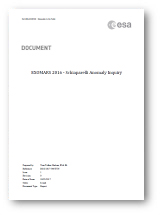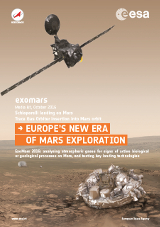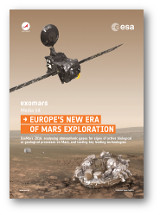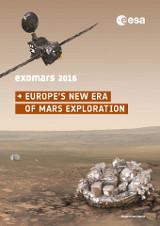ESA - Robotic Exploration of Mars - Publications Archive
Publication archive
Publication archive
The second ExoMars mission will be launched in 2020 to target an ancient location interpreted to have strong potential for past habitability and for preserving physical and chemical biosignatures (as well as abiotic/prebiotic organics). The mission will deliver a lander with instruments for atmospheric and geophysical investigations and a rover tasked with searching for signs of extinct life. The ExoMars rover will be equipped with a drill to collect material from outcrops and at depth down to 2 m. This subsurface sampling capability will provide the best chance yet to gain access to chemical biosignatures. Using the powerful Pasteur payload instruments, the ExoMars science team will conduct a holistic search for traces of life and seek corroborating geological context information.
© Jorge L. Vago et al., 2017; Published by Mary Ann Liebert, Inc. This Open Access article is distributed under the terms of the Creative Commons License (http://creativecommons.org/licenses/by/4.0), which permits unrestricted use, distribution, and reproduction in any medium, provided the original work is properly credited.
The scientific objectives of the ExoMars rover are designed to answer several key questions in the search for life on Mars. In particular, the unique subsurface drill will address some of these, such as the possible existence and stability of subsurface organics. PanCam will establish the surface geological and morphological context for the mission, working in collaboration with other context instruments. Here, we describe the PanCam scientific objectives in geology, atmospheric science, and 3-D vision. We discuss the design of PanCam, which includes a stereo pair of Wide Angle Cameras (WACs), each of which has an 11-position filter wheel and a High Resolution Camera (HRC) for high-resolution investigations of rock texture at a distance. The cameras and electronics are housed in an optical bench that provides the mechanical interface to the rover mast and a planetary protection barrier. The electronic interface is via the PanCam Interface Unit (PIU), and power conditioning is via a DC-DC converter. PanCam also includes a calibration target mounted on the rover deck for radiometric calibration, fiducial markers for geometric calibration, and a rover inspection mirror.
© A.J. Coates et al., and the PanCam Team, 2017; Published by Mary Ann Liebert, Inc. This Open Access article is distributed under the terms of the Creative Commons License (http://creativecommons.org/licenses/by/4.0), which permits unrestricted use, distribution, and reproduction in any medium, provided the original work is properly credited.
The search for evidence of past or present life on Mars is the principal objective of the 2020 ESA-Roscosmos ExoMars Rover mission. If such evidence is to be found anywhere, it will most likely be in the subsurface, where organic molecules are shielded from the destructive effects of ionizing radiation and atmospheric oxidants. For this reason, the ExoMars Rover mission has been optimized to investigate the subsurface to identify, understand, and sample those locations where conditions for the preservation of evidence of past life are most likely to be found. The Water Ice Subsurface Deposit Observation on Mars (WISDOM) ground-penetrating radar has been designed to provide information about the nature of the shallow subsurface over depth ranging from 3 to 10 m (with a vertical resolution of up to 3 cm), depending on the dielectric properties of the regolith. This depth range is critical to understanding the geologic evolution stratigraphy and distribution and state of subsurface H2O, which provide important clues in the search for life and the identification of optimal drilling sites for investigation and sampling by the Rover's 2-m drill. WISDOM will help ensure the safety and success of drilling operations by identification of potential hazards that might interfere with retrieval of subsurface samples.
© Valérie Ciarletti et al., 2017; Published by Mary Ann Liebert, Inc. This Open Access article is distributed under the terms of the Creative Commons License (http://creativecommons.org/licenses/by/4.0), which permits unrestricted use, distribution, and reproduction in any medium, provided the original work is properly credited.
The Raman Laser Spectrometer (RLS) on board the ESA/Roscosmos ExoMars 2020 mission will provide precise identification of the mineral phases and the possibility to detect organics on the Red Planet. The RLS will work on the powdered samples prepared inside the Pasteur analytical suite and collected on the surface and subsurface by a drill system. Raman spectroscopy is a well-known analytical technique based on the inelastic scattering by matter of incident monochromatic light (the Raman effect) that has many applications in laboratory and industry, yet to be used in space applications. Raman spectrometers will be included in two Mars rovers scheduled to be launched in 2020. The Raman instrument for ExoMars 2020 consists of three main units: (1) a transmission spectrograph coupled to a CCD detector; (2) an electronics box, including the excitation laser that controls the instrument functions; and (3) an optical head with an autofocus mechanism illuminating and collecting the scattered light from the spot under investigation. The optical head is connected to the excitation laser and the spectrometer by optical fibers. The instrument also has two targets positioned inside the rover analytical laboratory for onboard Raman spectral calibration. The aim of this article was to present a detailed description of the RLS instrument, including its operation on Mars. To verify RLS operation before launch and to prepare science scenarios for the mission, a simulator of the sample analysis chain has been developed by the team. The results obtained are also discussed. Finally, the potential of the Raman instrument for use in field conditions is addressed. By using a ruggedized prototype, also developed by our team, a wide range of terrestrial analog sites across the world have been studied.
[Remainder of abstract truncated due to character limitations]
The Mars Organic Molecule Analyzer (MOMA) instrument onboard the ESA/Roscosmos ExoMars rover (to launch in July, 2020) will analyze volatile and refractory organic compounds in martian surface and subsurface sediments. In this study, we describe the design, current status of development, and analytical capabilities of the instrument. Data acquired on preliminary MOMA flight-like hardware and experimental setups are also presented, illustrating their contribution to the overall science return of the mission.
© Fred Goesmann et al., 2017; Published by Mary Ann Liebert, Inc. This Open Access article is distributed under the terms of the Creative Commons License (http://creativecommons.org/licenses/by/4.0), which permits unrestricted use, distribution, and reproduction in any medium, provided the original work is properly credited.
 |
Reference: DG-I/2017/546/TTN
This is the report from the Schiaparelli Inquiry Board (SIB). The SIB was established for the following purpose:
- To establish the circumstances of the Schiaparelli anomaly;
- To establish the root cause of the anomaly and the reasons for this root cause;
- To establish recommendations for corrective actions;
- To establish consequences for the 2020 ExoMars mission in terms of lack of demonstration and associated recommendations for remedying of any shortfalls.
Report contents:
- Introduction
- Acronyms
- EDM/Schiaparelli system & mission description
- EDM/Schiaparelli validation approach
- The circumstances of the anomaly
- Investigation and findings from interviews & documentation review
- General observations and recommendations
- Consideration for ExoMars 2020 project
- Conclusion
This is the media kit for the ExoMars 2016 events on 19 October: the Schiaparelli module landing on Mars and the Trace Gas Orbiter insertion into Mars orbit.
Click on the image or on the Link to publication below to download the file (pdf, 7,2 MB)
Table of Contents:
Introduction
Why Mars?
What is ExoMars 2016?
Mission at a glance
Preparing to land on Mars with Schiaparelli
How and where will Schiaparelli land?
The journey to Mars
Operating at Mars
Science with the Trace Gas Orbiter
Planetary protection for Mars missions
Mission partners
Media services
Appendices:
A: Mission milestones
B: Arriving in orbit and landing on Mars: key events on 19 October
C: Selected images and videos
Errata:
pg 15: The distance between the Earth and
Mars on 19 October is 175 million kilometres (not 206 million kilometres).
In an earlier version of this document the media contact details for COMARS+ were incorrect. The media contact should have been listed as Manuela Braun (Manuela.Braun@dlr.de).
This is the media kit prepared for the launch of the ExoMars 2016 mission, which consists of the Trace Gas Orbiter and an entry, descent and landing demonstrator module, known as Schiaparelli.
Contents:
Why Mars?
What is ExoMars 2016?
Mission at a glance
Science with the Trace Gas Orbiter
The role of Schiaparelli
How and where will Schiaparelli land?
The journey to Mars
Operating at Mars
Planetary protection for Mars missions
Mission partners
Media services
Appendices:
A: Launch event at ESOC, Darmstadt, 14 March 2016
B: Selected images and videos
C: Mission milestones
D: Landing on Mars: key events on 19 October
Errata:
pg 5: the TGO science payload weighs 113.8 kg (not 112 kg).
pg 16: The distance between the Earth and
Mars on 19 October is 175 million kilometres (not 206 million kilometres).
pg 19: Schiaparelli was transferred to TAS-F in Cannes for testing; integration had been done at TAS-I in Turin.
pg 26: The correct title for Gerhard Kminek is Planetary Protection Officer
On 20-21 October 2015 seventy international scientists, project, and industry engineers gathered at ESTEC, in Noordwijk (NL) for the third ExoMars 2018 Landing Site Selection Workshop (LSSW#3). The workshop was co-organised by ESA and IKI/Roscosmos with the support of the ExoMars 2018 Landing Site Selection Working Group (LSSWG). The goal of the meeting was to review and discuss the merits and challenges of the four candidate landing locations remaining – Mawrth Vallis, Oxia Planum, Hypanis Valles, and Aram Dorsum – and recommend two final candidate landing sites for further detailed study and certification.
The final report with the outcome of the meeting is available here.
This ESA brochure describes the ExoMars programme, with particular emphasis on the mission due for launch in 2016.
The ExoMars programme comprises two missions. The first (due to launch in March 2016) consists of the Trace Gas Orbiter, which will investigate the biological or geological origin of important gases on Mars, plus Schiaparelli, an entry, descent and landing demonstrator module.
The second mission is planned for launch in 2018 and comprises a rover with drill and a stationary surface science platform. ExoMars is a cooperation between ESA and Roscosmos.
As a first output of their ExoMars 2018 Landing Site Selection (LSS) support activities, the Landing Site Selection Working Group (LSSWG) has been asked to examine all candidate landing site proposals; requesting where applicable additional information from the pro-posing teams, the science community, and industrial teams; to prepare a well-informed recommendation for up-to-four sites to be the scope of the next, more detailed stage of evaluation. Their recommendation is presented in this report.
Contents:
- Executive summary
- Document scope and introduction
- Landing site selection process
- Scientific constraints
- Engineering constraints
- Planetary protection constraints
- Proposed landing sites
- Recommendation for the narrowing of ExoMars 2018 landing sites
- List of acronyms and abbreviations
Reference: EXM-SCI-LSS-ESA/IKI-002
This document is a guide to preparing proposals in response to the Call for ExoMars 2018 Landing Site Proposals.
Please also refer to the Call for ExoMars 2018 Landing Site Selection (ref: EXM-SCI-LSS-ESA/IKI-001) and the ExoMars 2018 Landing Site Proposal Guide and Template (ref: EXM-SCI-LSS-ESA/IKI-002).
Reference: EXM-SCI-LSS-ESA/IKI-003
This Landing Site Selection (LSS) User’s Manual lists the scientific, engineering, and planetary protection constraints against which the ExoMars 2018 Landing Site Selection Working Group (LSSWG) will analyse proposed candidate landing sites. Please note that the landing constraints included in this document may need to be revised in case of changes in the spacecraft’s expected landing performance.
Please also refer to the Call for ExoMars 2018 Landing Site Selection (ref: EXM-SCI-LSS-ESA/IKI-001) and the ExoMars 2018 Landing Site Proposal Guide and Template (ref: EXM-SCI-LSS-ESA/IKI-002).
Reference: EXM-SCI-LSS-ESA/IKI-001
The European Space Agency (ESA) and the Space Research Institute of the Russian Academy of Sciences (IKI) [on behalf of the Russian Federal Space Agency (Roscosmos)] invite the scientific community to propose candidate landing sites for the ExoMars 2018 mission.
This document gives an overview of the call.
Please also refer to the ExoMars 2018 Landing Site Selection User's Manual (ref: EXM-SCI-LSS-ESA/IKI-003) and the ExoMars 2018 Landing Site Proposal Guide and Template (ref: EXM-SCI-LSS-ESA/IKI-002).



